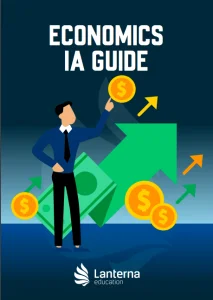If you’ll take your IB exams in 2022 (meaning you start the IB Diploma in 2020), you’ll be in the first cohort to study the new economics syllabus! The economics syllabus has been the same for the past 9 years, so you’ll be the guinea pigs of the new content. We at Lanterna took the time to comb through the new subject guide and compared it to the old one, to see just how different your course will be! We’ve highlighted a few differences, and some key similarities that you’ll need to be aware of. Check them out below.
Differences
New Units
The Economics syllabus has always been broken up into 4 main units but the new syllabus has changed these units up! Your 4 units (whether you study SL or HL Economics) are:
1. Introduction to Economics
10 teaching hours where you’ll look at questions like ‘what is economics?’ and ‘how do economists approach the world?’
2. Microeconomics
35 teaching hours for SL, 70 hours for HL where you’ll study concepts like supply, demand, government intervention, and market failure.
3. Macroeconomics
40 teaching hours for SL, 70 hours for HL where you’ll study measures of economic activity, macroeconomic objectives, demand-side policies, and supply-side policies.
4. The Global Economy
45 teaching hours for SL, 65 hours for HL where you’ll study the benefits of international trade, protectionism, exchange rates, balance of payments, sustainable development, and barriers/strategies to development
Changes from the Old Syllabus:
Previously Introduction to Economics was not considered a full unit, and the Global Economy was broken up into two smaller units (International and Development).
Exam vs. IA Weighting
If you’re studying SL Economics, your IA commentaries are now worth 30% of your overall grade. Paper 1 is also worth 30%, while your Paper 2 is worth 40%. So, your IA has become more important while your Paper 1 has decreased in value slightly!
If you’re studying HL Economics, your Paper 1 score makes up 20% of your overall grade, Paper 2 and Paper 3 make up 30% each, and your IA stands for the final 20%. So, the Paper 3 has become more important, while the Paper 1 has become slightly less!
Changes from the Old Syllabus:
SL: Previously your IA was only worth 20%, and both Paper 1 and Paper 2 were worth 40%.
HL: Previously your Paper 1 and Paper 2 were worth 30%, Paper 3 was 20%, and your IA 20%.
Want to get a headstart and find out what your IA is all about? Click the image to read our FREE guide!
HL Paper 3
Paper 3 looks completely different on the new Economics Syllabus. Paper 3 is now known as the ‘policy paper’. You will be asked to answer 2 compulsory questions. Paper 3 will largely focus on the quantitative elements in the syllabus, but there will be a greater need for definitions and explanations than in the past. The final part of each question will ask you to recommend a policy for the situation you were given.
Changes from the Old Syllabus:
Paper 3 was previously known as the ‘quantitative paper’ where very few questions required explanation or definitions. The focus of this paper has now slightly shifted, and may prove to be slightly more difficult (as evidenced by Paper 3 now being worth 10% more!).
Increased Focus on Sustainability
One of the only new topics in the syllabus includes a section on sustainability, the meaning of sustainable development, the sustainable development goals, and the relationship between sustainability and poverty. On top of having its own section, the concepts of environmental sustainability show up as key concepts through the entire syllabus. Typically when a new focus is added to a syllabus the IB will be keen to add questions about this topic on the first exams for that syllabus. So, if we were in your shoes, we’d make sure to really become familiar with all sustainable development topics, as they’ll more than likely show up on your exam!
Similarities
All in all, the new economics syllabus is very similar to the old one. Although there has been a restructuring of the units, a few topics have been expanded upon, and a few topics have been taken away, the core teaching will stay the same. Much of the content is identical to what it was previously, and the assessments (Exams and IA’s) have very little change.
We wouldn’t recommend using a textbook for the old syllabus as your primary source of information, as you’ll be missing the small differences between the two syllabi, but we strongly encourage you to still use exam papers from the old syllabus as helpful study tools, as a lot of questions will be very similar!
Let us know if you have any more questions about the new Econ syllabus and we’ll be more than happy to help in whatever way necessary! If you find yourself having trouble with the course content…
Find out more about our online tuition service!


